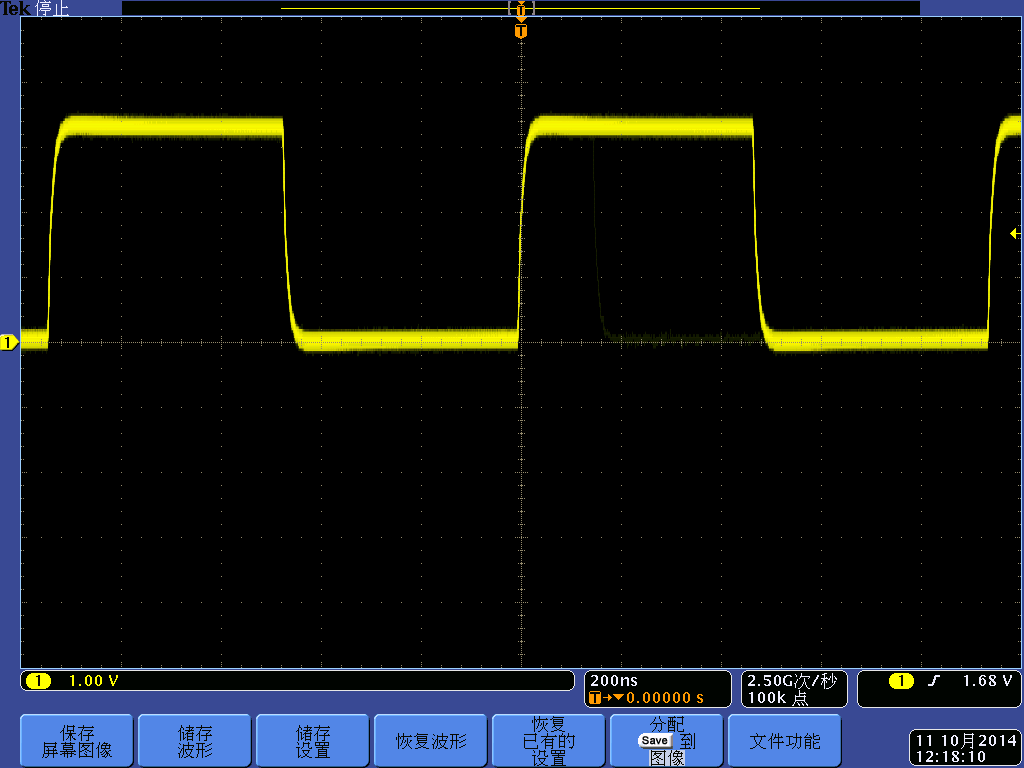
When digital oscilloscopes work, they always collect data first and then process and display the data. One thing that must be understood is that the oscilloscope's data sampling speed is far faster than the data processing speed, making it obliged to stop sampling during data processing. Inevitably, all the waveforms in the dead zone t2 are lost due to no acquisition. The basic principle of the oscilloscope is shown in Figure 2.

The parameter corresponding to the dead time of the oscilloscope is the waveform refresh rate of the oscilloscope, which is also called the waveform capture rate. The waveform refresh rate under the oscilloscope at a specific time can be measured through the TriggerOut interface. The higher the waveform refresh rate of the oscilloscope is, the better.
Waveform refresh rate F=1/(t1+t2)(wfms/s)
At a specific time base, the waveform time t1 is determined, and the higher the waveform refresh rate, the shorter the waveform dead time and the less the missing waveform. For example, for the T company's MSO4054, it has a waveform refresh rate of up to 50kwfms/s at a time base of 50ns/div, so the waveform time per second is equal to 50*10*50000=25ms, and the dead time is 975ms, so the waveform dead zone is as high as 97.5%, and the effective waveform observed by the user only accounts for 2.5% of the total waveform.
 ..
.. ZLG ZDS2022 oscilloscope also in the 50ns/div time base, the waveform refresh rate can reach 330,000wfms / s, so that the waveform time per second up to 231ms, about 9.24 times the T company MSO4054. Observing the same signal with two oscilloscopes, when the time base is adjusted to 200ns/div, ZLG ZDS2022 can find abnormal signals in a shorter time, but MSO4054 can not.

Many engineers still continue to use analog oscilloscopes today because analog oscilloscopes do not have waveform dead zones, but they also have other deficiencies. For example, they cannot do statistical analysis and cannot record data. This is the reason that analog oscilloscope users are getting fewer and fewer. the reason. In order to reduce the effect of waveform dead zone on signal analysis, it is recommended to select an oscilloscope with a high waveform refresh rate when purchasing an oscilloscope. However, I believe that in the future, digital oscilloscopes will completely solve the problem of dead zone of waveforms and allow electronic engineers to see the complete waveform. Wait and see!
Sintered Ferrite Magnet, hard ferrite, hard ferrite magnet is also called Ceramic Magnets.
Sintered ferrite magnets are available in isotropic magnet and anisotropic magnets. The magnetic properties of isotropic ferrite are low. Since they have nearly the same magnetic properties in all directions, so isotropic ferrite magnets can be magnetized in many different directions or in multi-poles. Anisotropic ferrite magnets have better magnetic properties compare with isotropic ferrite magnets. However this type of magnets can only be magnetized along a preferred direction.
Permanent ferrite magnets are made of hard ferrites, which have a high coercivity and high remanence after magnetization. Iron oxide and barium or strontium carbonate are used in manufacturing of hard ferrite magnets. The high coercivity means the materials are very resistant to becoming demagnetized, an essential characteristic for a permanent magnet. They also have high magnetic permeability. These so-called ceramic magnets are cheap, and are widely used in household products such as refrigerator magnets. The maximum magnetic field B is about 0.35 tesla and the magnetic field strength H is about 30 to 160 kiloampere turns per meter (400 to 2000 oersteds). The density of ferrite magnets is about 5 g/cm3.
The most common hard ferrites are:
Strontium ferrite, SrFe12O19 (SrO·6Fe2O3), used in small electric motors, micro-wave devices, recording media, magneto-optic media, telecommunication and electronic industry.
Barium ferrite, BaFe12O19 (BaO·6Fe2O3), a common material for permanent magnet applications. Barium ferrites are robust ceramics that are generally stable to moisture and corrosion-resistant. They are used in e.g. loudspeaker magnets and as a medium for magnetic recording, e.g. on magnetic stripe cards.
Why choose Ferrite Magnet?
1. Low cost and low price.
The raw material cost is very cheap and manufacturing process is simple. So the price if it is very low.
2. Nice temperature stability
Ferrite magnets can be used in the working temperature from -40℃ to 200℃.
3. Well prevent corrosion
The raw material of sintered ferrite magnet is oxide, so ferrite magnets will not be rusted under severe environment nor affected by many chemicals.
Ferrite Magnet,Block Ferrite Magnet,Round Ferrite Magnet,Hard Sintered Disc Ferrite Magnet
Jinyu Magnet (Ningbo) Co., Ltd. , https://www.magnetbonwin.com